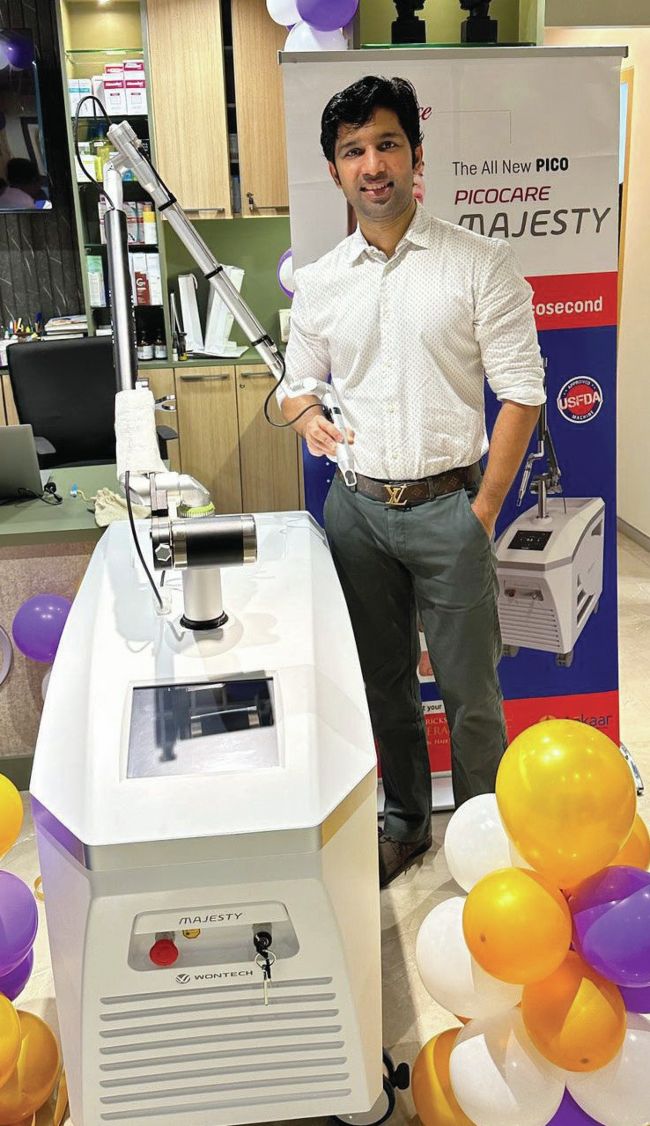MELASMA & PIGMENTATION

Dr Rickson Pereira
“Picosecond lasers offer much more pigment reduction responses than nanosecond lasers.”
Dr Rickson Pereira, Consultant Dermatologist and Head, Dr Rickson’s Dermatherapie Clinic, Mumbai & Consultant Dermatologist, Holy Family Hospital, Mumbai
How do you determine the appropriate treatment parameters for laser therapy for melasma and pigmentation, and what are some of the potential risks and complications associated with these treatments?
The laser device has preset parameters. The spot size, fluence, wavelength and frequency can be decided based on whether the location of the pigment is epidermal or dermal. That is a good guide to the initial settings that can be used. In subsequent sessions, the parameters like spot size, fluence and frequency can be modified based on the response. Potential risks and complications:
• Post-inflammatory hyperpigmentation (PIH) leading to worsening of melasma: This can happen if the laser parameters are too aggressive or if the patient does not follow post procedure care like photoprotection.
• Post-inflammatory hypopigmentation: This can happen if laser pulses are stacked with aggressive parameters.
• Redness: It can be erythema or purpura; self-limiting and clears out in 48 to 72 hours.
• Itching in those with atopic skin types: Responds to antihistamines, emollients and low potency corticosteroid creams.
What are some of the key benefits of picosecond lasers for treating melasma and pigmentation? Since when have you been using these in your practice?
I have been using the picosecond laser since a month now and I am thoroughly enjoying the results. In my experience, picosecond lasers are powerful and offer much more pigment reduction responses as compared to nanosecond lasers. With the same benefits of no downtime and long-lasting results, a quick response in a few weeks can be seen particularly in PIH.
How do you manage patient expectations when treating melasma and pigmentation with laser therapy, and what kind of post-treatment care do you recommend?
Medical management is essential for melasma treatment, while lasers are an adjunct therapy. Laser treatment only temporarily inhibits the melanocyte and resets its pigment production. Long-lasting results of laser treatment can be achieved with a good systemic and topical regimen. Patients are informed that melasma is typically a lifelong condition that can be lightened with topical medications and photoprotection. Maintenance of laser treatment results requires good home care.
After treatment, strict photoprotection is recommended, including the use of a tinted sunscreen with broad-spectrum protection against UV and HEV light. Patients should also use an umbrella or wear masks when outside between 09:00 am to 06:00 pm. Treatment with actives such as retinoids, AHAs, azelaic acid, and depigmenting agents with an irritant potential can be initiated two days post-treatment. A mild cleanser and a good emollient are prescribed for a few days post-treatment.
What kind of long-term follow-up do you provide for patients who have received the treatment, especially with the picosecond lasers?
We recommend treatments be repeated every two weeks for four sessions then once in a month for three to four months to maintain results. On follow up visits, patient feedback is taken via history and a quick clinical examination is performed to see results. Serial photographs are taken to monitor treatment results.